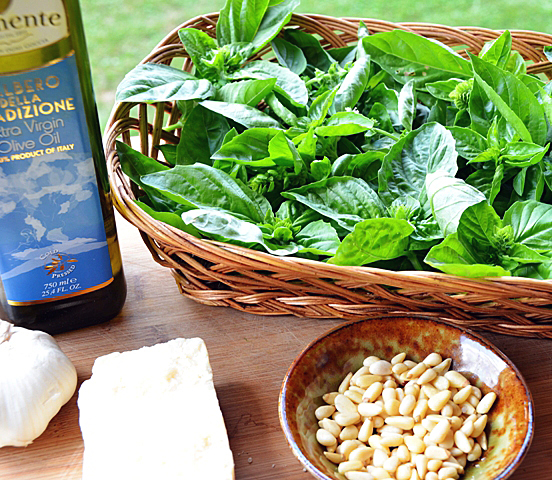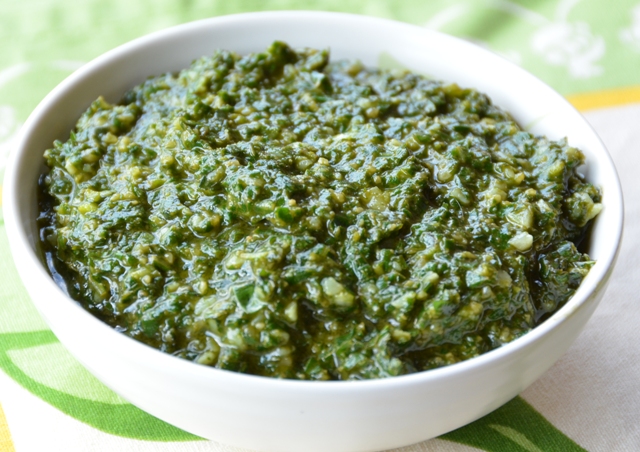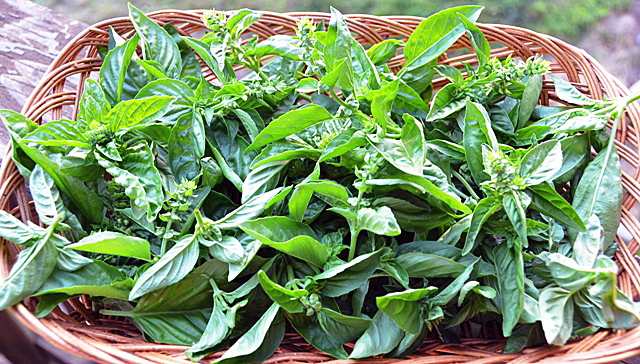Nothing is more evocative of summer than the scent of fresh basil in the garden. We grow many varieties, from the classic large-leaved Genovese, beautiful purple Dark Opal, scented varieties such as cinnamon, lemon, and lime, and miniature varieties that grow into perfect little ball shapes. One of my all time favorite ways to enjoy basil is in a delicious pesto sauce.
Originating in the northern Italian Riviera city of Genoa, pesto is a fresh uncooked sauce of basil leaves, pine nuts, grated cheese, olive oil and garlic. The word pesto derives from the Italian “pestare” to pound or to bruise.Traditionally, pesto was made in a mortar and pestle but now most people make short work of pesto by using a food processor. Several years ago we had the opportunity to teach a course on cooking with herbs at a local cookware store. One of the ways we engaged the participants in the class was to have them take turns using their muscle power to make pesto in a large mortar and pestle while I whizzed up a batch in my Cuisinart. The difference is remarkable. Pesto in the food processor is homogenized, very sauce-like while the mortar and pestle version was very creamy and had a great amount of definition and texture. I’m not saying every time you make pesto it needs to be made in the mortar and pestle but it is certainly worthwhile to try to see the difference and, you will get a mini-workout as well!
Pesto demands your freshest ingredients, basil, picked fresh from the garden or farmers market, fresh garlic, good quality pine nuts or walnuts, sea salt, freshly grated Parmigiano-Reggiano and your best extra virgin olive oil. Pesto will keep for about a week in the refrigerator. A thin layer of olive oil on top will help it retain it’s color. I freeze pesto without the addition of cheese in ice cube trays for seasons without basil. Just thaw out enough individual cubes for your recipe and add cheese to taste.
Basil Pesto
Makes 1 cup
Ingredients
- 2-3 cloves of peeled garlic
- 1/4c raw pine nuts or walnuts
- 1/4t sea salt
- 3c gently packed basil leaves
- 1/2c extra-virgin olive oil
- 1/2c freshly grated Parmigiano-Reggiano

Directions
Food processor method
- Process the garlic, nuts and salt until finely ground, about 20 seconds. Add the basil leaves and process in spurts just until no whole leaves remain. With the machine running, pour the oil through the feed tube in a steady stream. Stop and scrape down the sides, then process again for several seconds. Some of the texture of the leaves should remain. Add the cheese and pulse until incorporated.
Mortar and Pestle method
- Remove stems and center veins from basil leaves. Put one cup of basil leaves and the salt in the mortar, and using the pestle, press and pound the leaves against the sides of the bowl in a rotating motion, the salt provides some “traction”. Continue to add leaves as they break up and grind them until they are all used. Add the pine nuts and grind them into the sides of the bowl. Stir in the grated cheese and slowly stir in the extra virgin olive oil.

